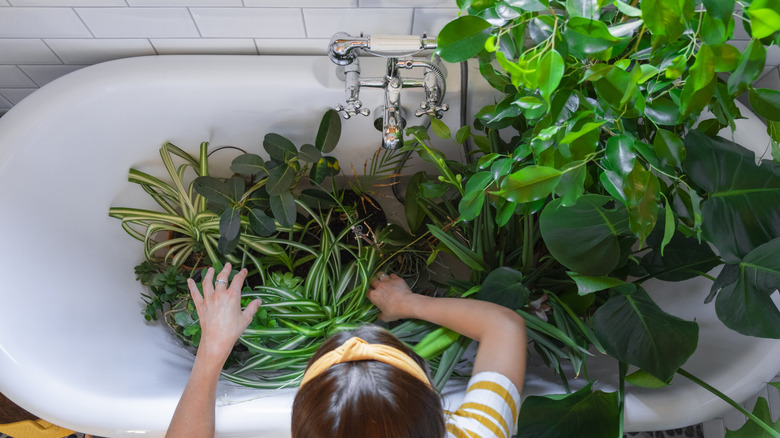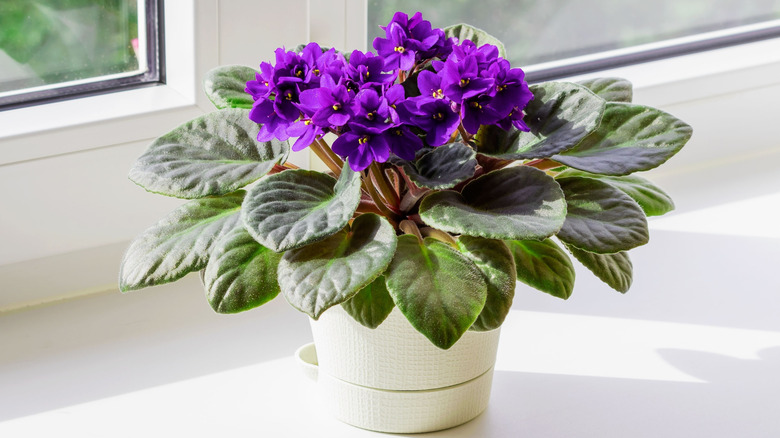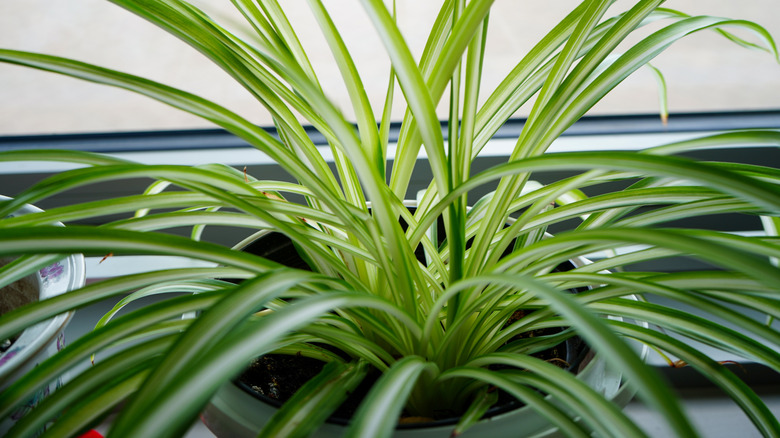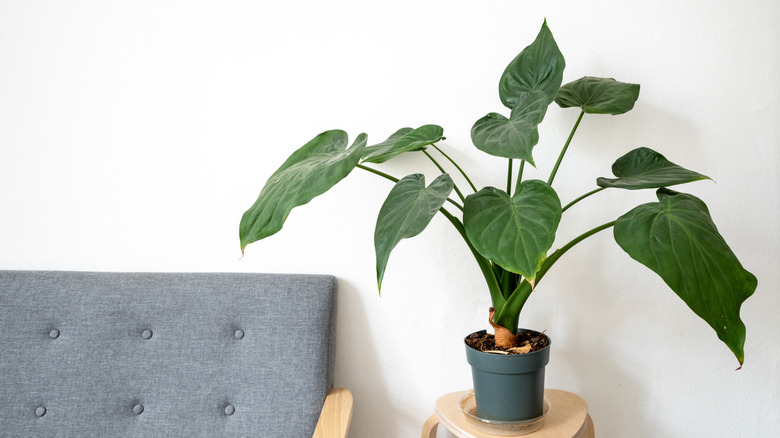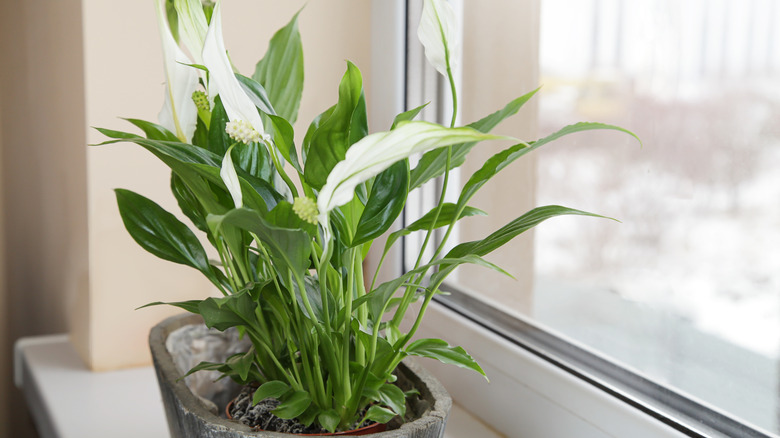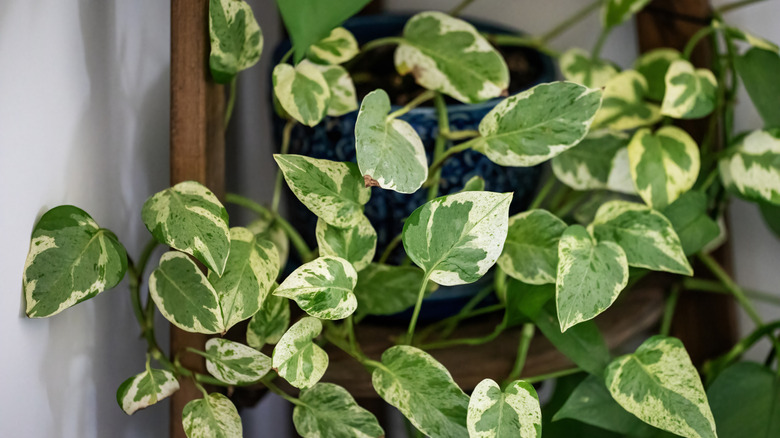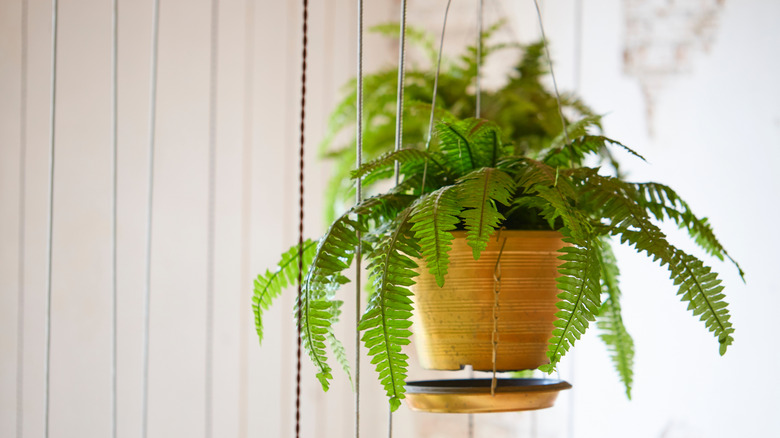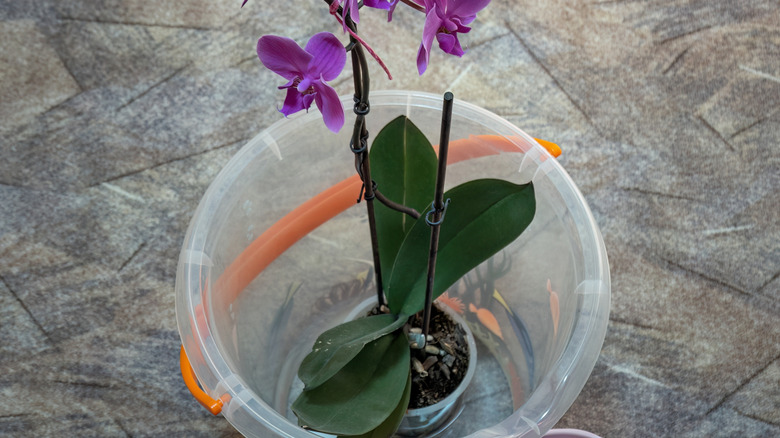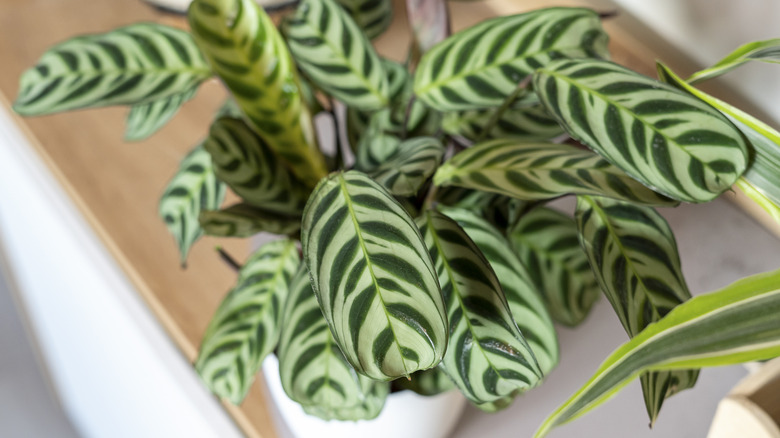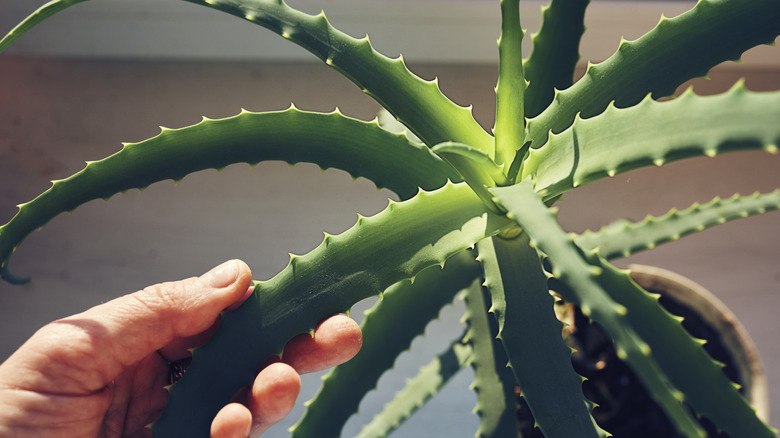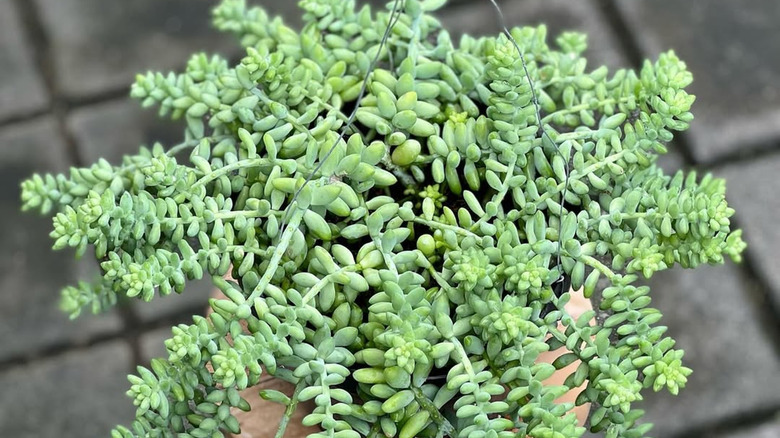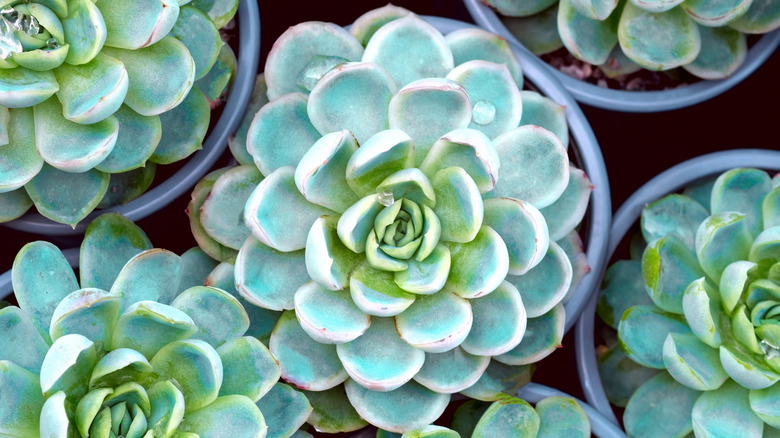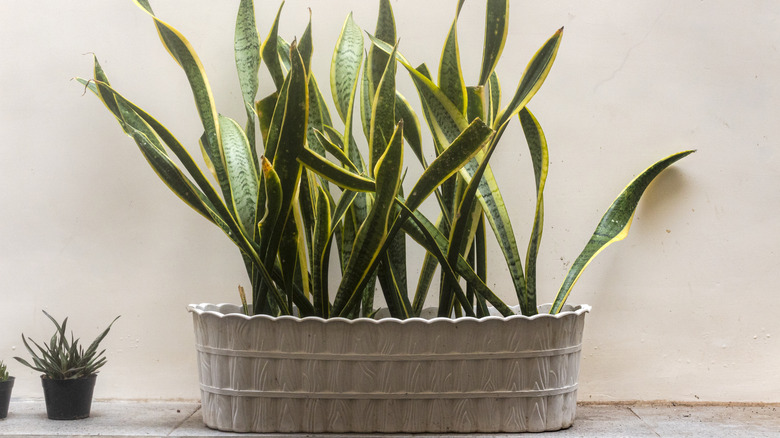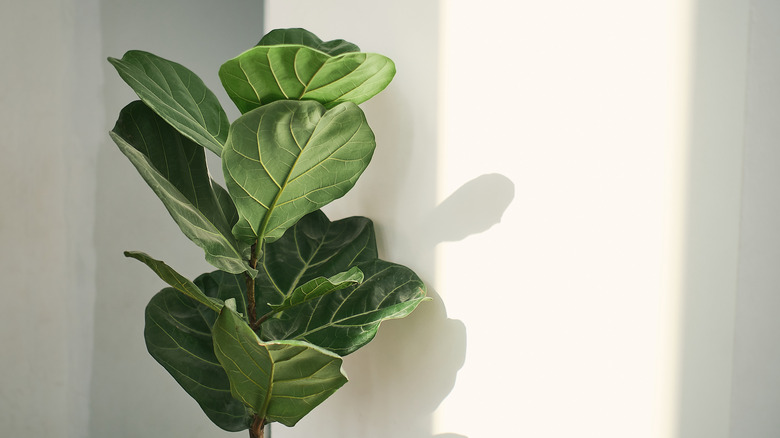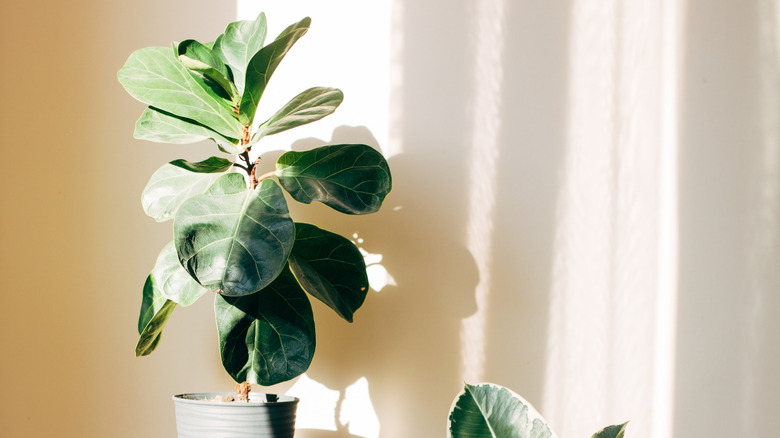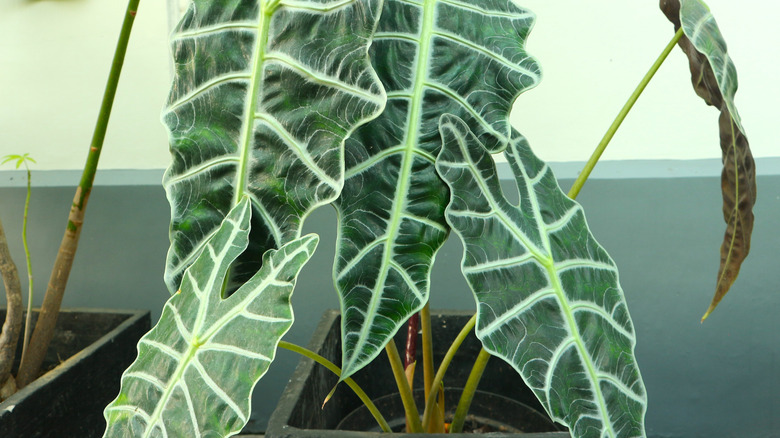The 8 Houseplants You Should Be Bottom Watering (And The 7 Ones You Shouldn't)
You don't have to be a gardening guru to know that water is essential for plant health. Typically, watering a plant entails pouring water right onto the soil, but how much water is enough? Bottom watering eliminates this question because the soil stops absorbing water from below once it's fully soaked. Many houseplants benefit from bottom watering, but those with sensitive leaves like African violets and ferns are especially good candidates. Meanwhile, plants with shallow roots, like snake plants or aloe vera, are better off watered from the top.
Bottom watering your houseplants is simple, although it takes more time than top watering. You simply have to place the plant, pot and all, into a container of water. A phenomenon called "capillary action" causes the water to move upward into the dry soil through the pot's drainage holes. Like a sponge, the soil soaks up water until it's saturated. This method can provide a more thorough and consistent watering, whereas watering from the top sometimes results in water only hitting the sides or the top of the soil. Depending on the type of soil, it may take up to an hour to become thoroughly moist.
Bottom watering is only practical for potted plants that are small and light enough to carry. Plus, with larger pots, it would take too long for all that soil to absorb water. But for plants that prefer bottom watering, it's an excellent way to promote root health and reduce guesswork as to how hydrated the plant is. You should still top water on occasion to prevent the buildup of salts in the soil.
African violet
African violets (Saintpaulia ionantha) make great indoor houseplants, although they need plenty of light to flourish. They produce colorful blooms that now come in more colors aside from violet. However, these plants have delicate leaves, and they can develop permanent spots with just a splash of water. Wet leaves can also lead to fungal diseases, like powdery mildew. Bottom watering is the ideal solution. Don't let your African violet sit in water for more than 30 minutes at a time to prevent root rot. And to avoid overwatering, only water the plant when the top of the soil is dry.
Spider plant
Spider plants (Chlorophytum comosum) are a popular plant due to how easy-going they are, but even low-maintenance plants need consistent watering to thrive rather than just survive. Spider plants do well with bottom watering; it's particularly helpful if the soil has gotten very dry because it ensures a deep and even soak. Another watering trick that'll help spider plants thrive is to use filtered water, as they're sensitive to some common chemicals in tap water. It's better to err on the side of underwatering than overwatering with these plants.
Philodendron
Philodendrons are known for their thin, heart-shaped leaves, and there are hundreds of different species available. These low-maintenance houseplants prefer moderate amounts of water; every week or two is generally enough. Bottom watering works well because they have dense root balls that can effectively soak up lots of water to become stronger. Set your philodendron in a container of water for about an hour or until the top of the soil is moist. The only time when top watering is better for a philodendron may be just after repotting.
Peace lily
A favorite for low-light indoor spots, peace lilies (Spathiphyllum wallisii) prefer consistently moist soil. Bottom watering is the best method for watering peace lilies, as it helps ensure that the bottom of the roots are getting enough moisture each time. Watering every 7 to 10 days is a good benchmark, but check the soil to make sure it's the right time — it should be slightly dry, but not fully. Try not to let your peace lily dry out so much that it wilts, which shows that it's stressed.
Pothos
Pothos (Epipremnum auream) is a common houseplant for beginners and experts alike, with its low care requirements and beautiful trailing leaves. These plants prefer to fully dry out between watering sessions; they're more vulnerable to overwatering than underwatering and can quickly succumb to root rot. Their root balls soak up water from the bottom more easily than from the top, and this prevents any risk of the plant roots standing in water afterward. Let the pothos sit in water for around 30 minutes, then lift it and let it drain any excess water.
Fern
Ferns are a houseplant group that is just as beloved for outdoor landscapes as indoors. They're ideal for shady areas since they evolved to grow under tree canopies, and they enjoy humidity and moist soil. However, it's best for the fronds to stay relatively dry because they can easily develop fungal diseases. Bottom watering allows the root balls to get all the water they need without any water touching the fronds. It's also a less messy, more dependable watering method for hanging ferns compared to top watering.
Orchid
Orchids have quite a reputation for being difficult, and improper watering is one of the most common reasons for orchids to die. One easy method is to dip the orchid in water once a week, especially those potted in bark mixture — bark repels water at first, so it takes some time to saturate. In this case, the water that comes up from the drainage holes into the pot should stop just below the lip of the pot. It's always important to allow thorough draining after bottom watering, but be mindful of it with orchids in particular, as they hate sitting in water.
Calathea
Calatheas, also known as prayer plants, are an example of a non-succulent plant with shallow roots like succulents. However, unlike a succulent, calatheas prefer consistently moist soil; only the top layer should dry out between waterings. So you are likely to get good results with bottom watering. This way, you can get water to the root system while the top of the soil remains dry, reducing the risk of rot. Top watering could also work as long as you drain away any excess water. Either way, don't let the plant sit in water for long. Continue checking on it and allow it to fully drain after watering.
Aloe vera
Another popular houseplant, aloe vera (Aloe barbadensis), is a type of succulent, so it stores water in its leaves and can easily withstand drought. That's why aloe vera is known for being pretty low-maintenance — not only does it not require frequent watering, but it actually benefits from drying out thoroughly. As a succulent, it also has shallow roots, so top watering can be more effective than bottom watering. Plus, aloe vera should never sit in water: After the water has flowed through to the drainage tray, empty it out.
Sedum
Sedum is also known as stonecrop, and it's commonly grown in outdoor gardens as well as indoor pots. When grown outdoors, it's hardy from USDA zones 3 to 10. Garden bed sedum obviously can't be bottom watered, but even when growing this plant in containers, top watering is ideal since sedum is another type of succulent with shallow roots. It easily rots if over-watered, so a well-draining potting mix is also essential, and it's important to water only when the soil is thoroughly dry (not just the top inch).
Echeveria
Echevaria is another drought-tolerant succulent that prefers dry conditions and can go a while without water. It's most often grown as a houseplant and prefers to be watered from the top due to its shallow roots. However, avoid getting the leaves wet; instead, aim your watering can nozzle directly at the soil. Overwatering is also a risk with Echevaria — if you see dropped, yellow, or mushy leaves, along with mushy stems, you know you've watered too often.
Snake plant
Snake plants (Dracaena trifasciata) are one of the most popular, low-maintenance succulents of all; they can adapt to a range of light conditions and are hard to kill by underwatering. Overwatering, on the other hand, is a common snake plant issue, as their roots can easily rot. About every two weeks is usually the most often a snake plant would want to be watered; let the soil get completely dry in between. Since it also has shallow roots, top watering is the way to go. Remove water that pools in the drainage tray after watering.
Fiddle leaf fig
Fiddle leaf figs (Ficus lyrata) can be tricky for plant owners to keep alive. While these plants thrive on consistent watering routines, and the roots need a good soaking each time, overwatering is still one of the most common issues with them. With these plants, it may be best to switch between bottom watering and top watering. Bottom watering ensures that the roots get water and prevents water damage to the sensitive leaves, while top watering mimics a natural rainfall for these tropical plants. Allow the top 3 to 6 inches of soil to dry out between waterings.
Rubber plant
Rubber plants (Ficus elastica) are related to fiddle leaf figs, but easier to take care of. They like to almost dry out between waterings, and bottom watering won't do any harm. But these are also tropical plants with sizeable leaves that are prone to dust accumulation, with leaves that like to stay a bit moist. Top watering can help keep them clean and healthy. Filtered water is preferable, or the leaves may burn on the edges over time.
Alocasia
Also known as elephant ear plant, Alocasia has a thick, fleshy root system that is not recommended for bottom watering. These roots can easily suffer from excessive water and develop root rot or other fungal diseases. Water from the top until water flows into the drainage tray, then empty the tray. It also helps to boost humidity around the plant by placing it on top of a pebble tray, in a bathroom, or in a laundry area.
